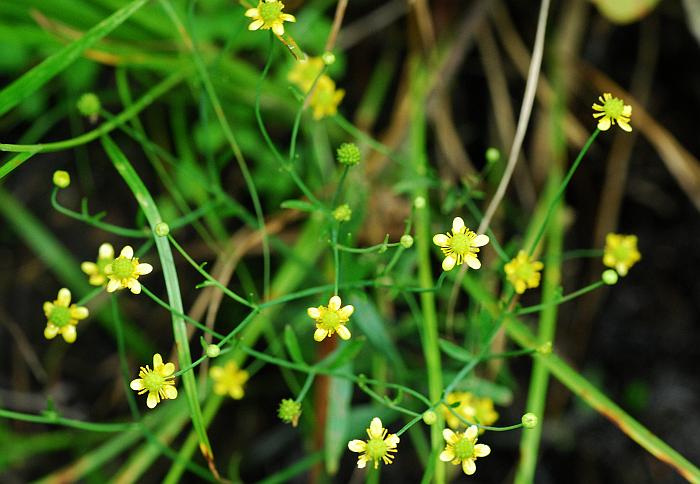Ranunculus laxicaulis (Torr. & A. Gray) Darby
Water-Plantain

Native
CC = 7
CW = -5
MOC = 18
© SRTurner
Ranunculus laxicaulis (Torr. & A. Gray) DarbyWater-Plantain | |
 |
Native CC = 7 CW = -5 MOC = 18 |
© SRTurner |
|
Family - Ranunculaceae Habit - Annual forb, roots not tuberous. Terrestrial or emergent aquatic.
Stem - Glabrous or nearly so, branched, weakly ascending, often reclining in aquatic habitats. Bases not bulbous. Roots not tuberous.
Leaves - Basal leaves long-petiolate, oblong or ovate, usually absent at flowering. Stem leaves to 7 cm, simple, sessile, entire or few-toothed toward the tips, ovate to narrowly elliptic to linear.
Flowers - Sepals 4 or 5, to 3.0 mm long, spreading or reflexed, deciduous at anthesis. Petals 4-6, 2-6 mm long, 1-2 mm wide, oblong, about as long as to somewhat longer than the sepals, yellow.
Fruits - Fruit clusters globose, 2-4 mm long at maturity, the receptacle glabrous. Achenes 0.8-1.0 mm long, the dorsal margin keeled and sometimes very narrowly winged, the wall thick, smooth, glabrous, the beak 0.1-0.2 mm long, flattened, triangular, straight or bent to the side.
Flowering - April - September. Habitat - Margins of ponds, sinkhole ponds, sloughs, streams, wet swales. Origin - Native to the U.S. Lookalikes - Other small-flowered species of Ranunculus, e.g. R. parviflorus, R. pusillus. Other info. - This little Ranunculus is uncommon in Missouri, where it is found mostly near the Bootheel and toward the southwestern portion of the state. Beyond Missouri it is found in few other southern and southeastern states, but is not common anywhere. Like other members of the genus, its flowers are glossy yellow. Although the flowers are quite small, their abundance provides a bright sprinkling of color in the wet places where the plant is found. Photographs taken at a sinkhole pond at Western Star Flatwoods, Phelps County, MO, 6-9-2018, and at Tingler Prairie Natural Area, Howell County, MO, 6-10-2021 (SRTurner). |